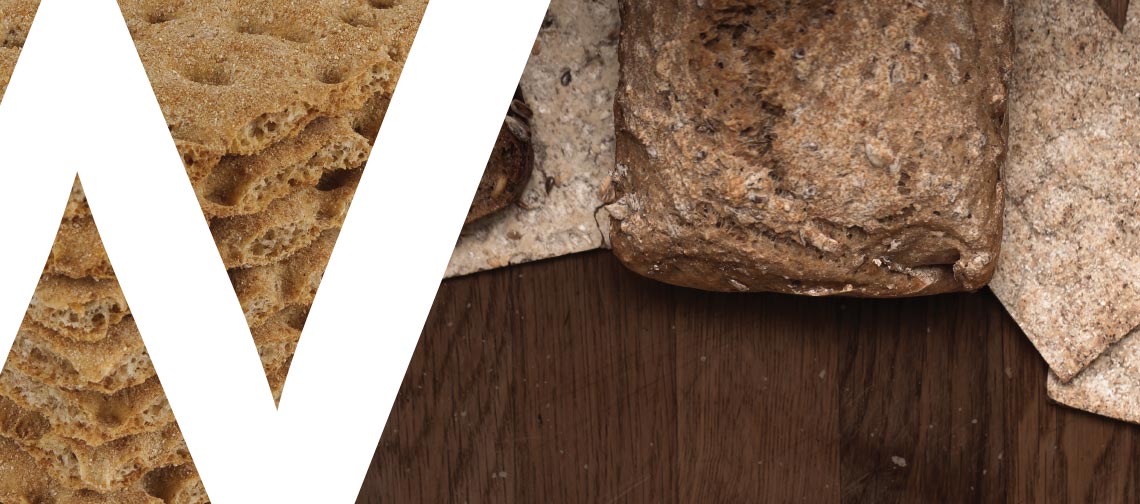There is a custom not to eat matzah for thirty days before Pesach. However, this only applies to kosher for Passover, plain matzah. There are matzos that have other ingredients, like salt and spices, that do not fall under the category of lechem oni (poor man’s bread).
ALTHOUGH WASA CRISPBREADS RESEMBLE MATZAH IN SOME WAYS, THEY ARE NOT KOSHER FOR PASSOVER!
The OK Kosher consumer hotline receives many inquiries regarding Wasa Crispbreads. It seems that kosher consumers like buying Wasa Crispbread, yet this product is somewhat of a mystery. Is it a bread, a cracker, or a matzah? It is not as soft as bread, yet not as hard and flat as matzah. Each slice of the crispbreads weighs 11 grams (less than 1/3 of an oz.), and is about 1/3 of an inch thick. It is also made mainly out of rye, not wheat, and is imported from Sweden or Germany.
-
WHAT IS CRISPBREAD?
Crispbread has been eaten for about 1,500 years in Sweden and Finland. These crackers are traditionally made from whole meal rye flour, water and salt. The dough does not rise much and the therefore does not become as soft as bread. Crispbreads are baked flatter and more dry, and therefore, keep fresh for a long time. This is why crispbread is also called “knackebrod” or “hartbrod” (hard bread) in Sweden.
In Scandinavia, crispbread used to be considered a poor man’s bread. They used to be made in the form of a round flat bread with a whole in the center. The bread would then be stored (for the winter) on long poles hanging from the ceiling.
The first industrial bakery began producing crispbread in 1850 in Stockholm, Sweden. Wasa or the Wasabrod Company opened its first bakery in 1919. (Incidentally the name Wasabrod does not get its name from water bread. Rather it was named after King Gustavus Vasa.)
-
HOW DOES THE BREAD COME OUT SO LIGHT?
Generally, yeast or sourdough is used in bread production to make the dough rise and achieve the characteristic lightness. Years ago, Scandinavian bakers would mix snow or powdered ice into the dough. Then, when the dough was baked, the water would evaporate and leave spaces in the bread.
-
WHAT INGREDIENTS ARE USED IN WASA CRISPBREADS?
Though the main ingredients of this bread are rye flour, water and salt, various other ingredients are added to diversify the taste and texture. These include: sour dough, yeast, oat flakes, wheat flour, barley flour, light rye and rosemary.
 In general, rye is considered a second class grain which was usually used by the masses, while bread made from white wheat flour was usually the bread of choice for the rich. Rye does not rise as much as wheat flour, and it remains moist longer; therefore, rye crispbread lasts for a long time.
In general, rye is considered a second class grain which was usually used by the masses, while bread made from white wheat flour was usually the bread of choice for the rich. Rye does not rise as much as wheat flour, and it remains moist longer; therefore, rye crispbread lasts for a long time.
Crispbread is known to contain a large amount of dietary fiber. This is because they use whole grain rye, which contains very little fat. Though they do contain some gluten, rye has less gluten than wheat.
-
IS WASA CRISPBREAD KOSHER?
Of course it is, BUT NOT FOR PESACH! Just look for the OK Kosher symbol proudly displayed on the bottom left of the package!
Consumers often ask if the product is dairy, because the packaging of the German produced crispbreads says “May contain milk”! Halachically, one may not make DAIRY bread, even if its ingredients are kosher*. Our Sages decreed many years ago that bread cannot be dairy or meat, because bread is the main part of the meal and is usually pareve. If it would be dairy/meat, people may mistakenly eat the bread at the wrong meal.
*NOTE: There are some exceptions to this law.
Wasa Crispbread is made in both Sweden and Germany. Only the German made products have a milk warning on the label. We asked Rabbi Osher Gutnick, Europe Coordinator at OK Headquarters, and he answered the following:
“It’s not dairy; that statement is an allergen warning required by law, because there are other (non-certified) production lines in the facility that handle dairy. There may be (halachically insignificant) cross-contaminations, such as airborne particles, but the product is pareve.”
-
WHAT ABOUT PAS YISROEL?
In Shulchan Oruch, Yoreh Deah, Siman 112 it says, “The Rabbis prohibited one to eat bread made by a non-Jewish baker (friend), as it can bring (to closeness and eventually to) intermarriage. The Rama adds that it is prohibited even when it will not bring to intermarriage.”
In Se’if 3, he adds, “There are some (places) that are lenient and allow buying bread from a baker that sells bread for a living, Pas Palter, (as it is his business, not a personal gesture), if there are no Jewish bakers available. Some even permit it when there are Jewish bakers available. (Yet clearly it is prohibited to receive bread baked by a non-Jewish friend.)”
Even those who take the lenient approach to Pas Palter, are told that this leniency should not be used during the Aseres Yemei Teshuva from Rosh Hashanah through Yom Kippur.
In our case, where the Wasa crispbread is baked in a commercial bakery, would we be permitted to eat it if we are careful not to eat Pas Palter?
In Se’if 9, he says “If a Jewish person lights the fire and the non-Jew bakes …. Even if (the Jew) only added one small piece of wood towards the fire, it is permissible to eat. This is because it was meant as a subtle reminder (not to become that close)…”
At this point, I would like to quote Rabbi Gutnick:
Wasa crispbread is produced in two plants, in Germany and Sweden. Both have similar systems in place to ensure the Pas Yisroel status of the crispbreads. The crispbreads are baked in electric-powered tunnel ovens, which have been switched on and raised to the correct temperature by our mashgichim, enabling Pas Yisroel production. These are very large ovens which operate continuously, using a conveyor system.
During the company’s summer and winter breaks, production is paused and the ovens are lowered slightly, but always maintain a minimum temperature of 350 C, because it takes a very long time for these ovens to cool down and reheat. In fact, the ovens are so large that it would take about 14 days for them to cool down completely. The company does not want to waste this valuable production time.
OK mashgichim visit the plants every other month to check production and maintenance records and confirm that the ovens have been operating continuously. Additionally, they lower and raise the temperature of the ovens by a few degrees Celsius. This way they contribute to the baking process in the form of hashlachas keisam (adding fuel to the fire), as explained above. They also visit the plants at the conclusion of every summer and winter break, to raise the ovens prior to resuming production.
-
WHAT BRACHA DO WE MAKE ON THIS CRISPBREAD?
In Shulchan Oruch, Orach Chaim, Siman 168, Se’if 7, it says that on Pas Haba B’Kisnin (a breadlike food that is usually eaten as a snack), we say borei minei mezonos. Then, it discusses three opinions on what Pas Haba B’kisnin is:
- Bread (flour and water that is shaped like a pocket [like a pita or knish]) that is filled with fruit before it is baked.
- Bread made with flour that was kneaded with honey, milk, oil, eggs or fruit juices.
- Bread that was made with water and without any filling, yet it is usually used for a snack since it is baked as a thin cracker.
Accordingly, it would seem that Wasa crispbread should fall into category 3 and require the brocha mezonos. Yet, even though the halacha is that we follow all three opinions, the Baal HaTanya seems to hold that it is better that one eat this (unflavored) cracker during the meal. (Note: please see the previous article in the Tishrei 5771 edition of Kosher Spirit.)
But, there is another problem here. In the third interpretation of Pas Haba B’kisnin, we are talking about bread that was baked originally in a cracker form. If the cracker was baked originally in a bread form and then made into a cracker, it would require hamotzi. This is the reason that we make hamotzi on melba toast (of flour and water) and flavored bread croutons (as per Rabbi Belsky, a”h), since they were originally baked as bread. In Shulchan Oruch, we are told that the only way that a hamotzi bread turns into a mezonos bread is if it loses “Toireesa D’Nahama” (the form of bread).
Even on the Wasa Crispbread website, it’s obvious that the crispbread is baked as a whole bread first (note the bolded words stating that they are slices):
Light in many ways! Lightly baked, extra-fine slices of our mildest whole grain rye flavor are in our Wasa Light Rye Crispbread. The delicate taste complements even the mildest topping. Lightly crispy…and only 30 calories per slice.
Wasa crispbread is made originally as a large matzah, and then sliced into small cracker sized pieces. There is a question whether all matzah is mezonos or hamotzi. We all know that matzah during Pesach is hamotzi, yet when we eat matzah after Pesach, there are various opinions. Many Sefardim would make a brocha mezonos year round, while most Ashkenazim opine that you would make hamotzi. If so, it would seem that Ashkenazim may have to make hamotzi on Wasa crispbread.
Consequently, it would seem that we would make hamotzi on the crispbread. We would also need to bentsch, if we eat the proper minimum amount.
Hoping that this helps clarify the Wasa Crispbread in a crisp clear manner!







